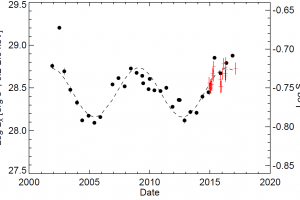Cycles of chromospheric and coronal activity. Published by A&A “Fifteen years in the high-energy life of the solar-type star HD 81809” of S. Orlando (INAF-OAPA)

An observation in X-rays of a single star 15 years long…The objective? The understanding of the coronal cycle in stars: do solar-like stars have a coronal cycle such as the one of our Sun?
The term “solar activity” includes all those phenomena observed in the solar photosphere, chromosphere, and corona related to the solar magnetic field, such as sunspots, flares, and prominences. In the Sun the morphology and intensity of the magnetic field has a 11-years cycle, which also characterizes all the “solar activity” phenomena.
Obviously, since solar-like stars have the same internal structure of our Sun, their magnetic field is produced and evolve in a similar way. Do these stars have a magnetic cycle? If yes, does it have a 11 years period such as in the Sun? A first insight in this direction has been provided by the long term monitoring of the chromospheric activity of a large sample of stars made with Mt. Wilson observatory. This survey shown that 60% of the solar-like stars have a chromospheric cycle, whose period range between 2.5 and 25 years.
Very few information is known on the coronal cycle of stars, which can be observed in the X-rays band. Our knowledge in this field is in fact hampered by the lack of long term observations in X-rays of solar-like stars. With one exception: the 15-years long monitoring of the star HD 81809 with the X-ray satellite XMM/Newton. HD 81809 is a binary system of two solar-like stars, with a large separation and very slow stellar rotation. The results of this long monitoring have been presented in the paper “Fifteen years in the high-energy life of the solar-type star HD 81809. XMM-Newton observations of a stellar activity cycle” of S. Orlando (INAF- Astronomical Observatory of Palermo), recently published on Astronomy & Astrophysics. This study has discovered a coronal cycle of HD 81809 with a period of about 7 years, similar to the chromospheric cycle. These unique set of data have also allowed the astronomers to analyzing the distribution of coronal active regions across the cycle, providing evidence that the coronal cycle of this star is similar to the solar cycle.
The figure (link) shows the periodic variation of X-ray luminosity of HD 81809 observed with XMM Newton.
